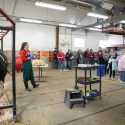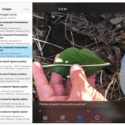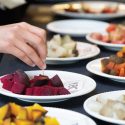How UW helped Nasonville Dairy become an industry leader
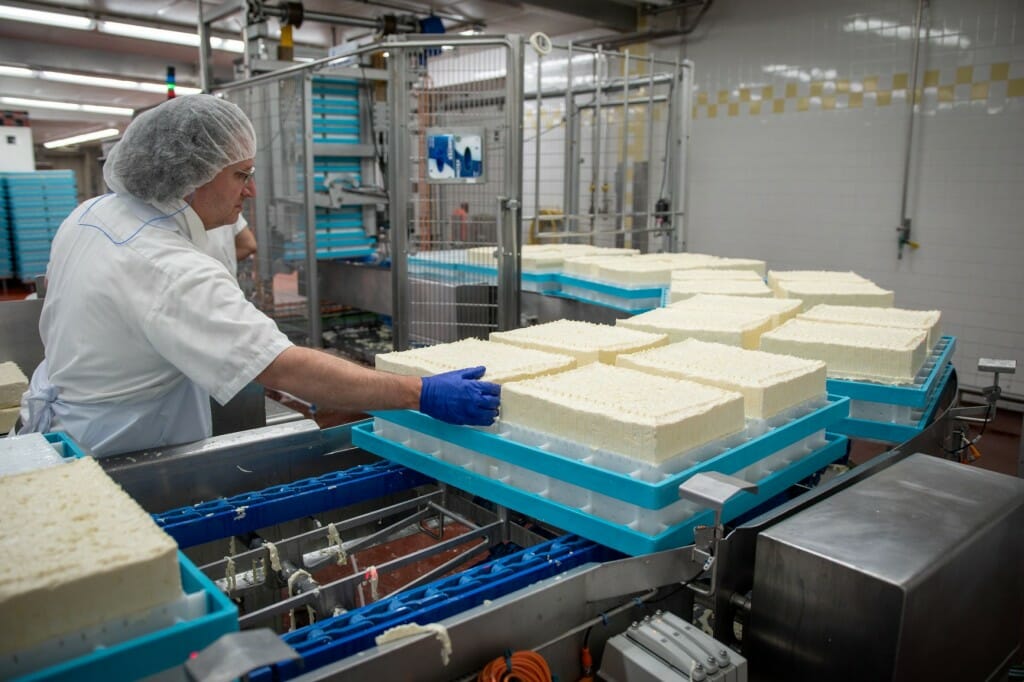
Nasonville Dairy in Marshfield has been making Feta cheese since 1986. UW-Madison CALS
From February through June, we will highlight the ways that UW–Madison powers the state’s economy through research and innovation, educates the next generation and reaches out to Wisconsinites to improve their lives. February’s theme is Economic Prosperity. Watch for more at #CantStopABadger and #UWimpact on social media. Your support can help us continue this work.
The Center for Dairy Research’s work with Nasonville Dairy, a family-owned dairy processing plant in Marshfield, Wis., highlights the ways that CDR helps Wisconsin dairy processors succeed.
CDR has helped Nasonville develop new cheese products for export, start ultrafiltration lines to produce lactose-free milk, and trouble-shoot quality problems that pop up.
Founded in 1885 in Wood County, Nasonville Dairy has evolved and changed hands over the years. In 1968, Arnold and Rena Mae Heiman arrived at the plant and joined the plant’s Co-Op as managers. They brought with them their three sons, Ken, Kim and Kelvin, and daughter, Kathy. In 1985, the Heimans purchased the plant and reinstated its original name – Nasonville Dairy.
Ken Heiman, who now owns the plant with his brothers, became a licensed cheesemaker through CDR at age 16 and is also a Wisconsin Master Cheesemaker. In recent years, the plant has continued to evolve and expand.
“When our father brought us here in the late 60s, this plant ran 7,500 pounds of milk a day,” Ken Heiman said. “Today, it runs 1.5 million a day. Things have changed immensely. We’re always looking for the next new market, the next new venture, the next new product that people are looking for.”
Today, Nasonville Dairy produces about 46 million pounds of cheese a year and makes more than 40 flavors of cheese. A recent expansion has boosted its Feta production with a new brine system and packaging line.
CDR, part of UW–Madison’s College of Agricultural and Life Sciences, supports Wisconsin’s dairy industry through education (short courses and trainings), product development and technical troubleshooting.
CDR and Nasonville Dairy
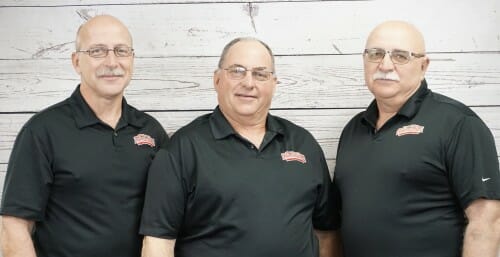
Kim, Kelvin and Ken Heiman of Nasonville Dairy in Marshfield. UW-Madison CALS
CDR and Nasonville Dairy have worked together for so long that Heiman isn’t exactly sure how or when it started.
“I’m sure we reached out to CDR for a plant problem or some quality issue,” he says. “I would guess that 90% of the companies began their relationship with CDR over a problem.”
When asked how CDR has helped Nasonville Dairy over the years, Heiman lists a number of cheese issues like consistency, color and quality (slits/cracks). CDR has also helped Heiman change the way his plant uses its equipment. For example, the company expanded its production of Feta cheese and has specialized equipment for Feta production, but Heiman wanted to know if they could make other cheeses with that same equipment.
“We have all this equipment for Feta,” he said. “Well, I want to know what else can I do with it? John Jaeggi (CDR Cheese Industry and Applications Coordinator) has worked with us in making fresh Mozzarella on there. We’ve made Cotija and Snow Feta on there. We have an idea and we ask, ‘How can I make this work?’ That’s where CDR has been extraordinarily helpful to us.”
By better utilizing equipment, Nasonville has been able to produce more cheese more consistently and efficiently. Producing consistent, high-quality cheese is essential for success. Heiman said CDR has helped Nasonville Dairy better understand acid development, which has helped produce more consistent cheese, “We have to understand how we get from point A to point B.”
Another example, Nasonville Dairy ran into quality issues in its cheese. “We were getting these very large holes in the cheeses and it would cause all these inconsistencies. We had to figure out where this was coming from,” Heiman said. Eventually, with the help of CDR, it was discovered that there were some fermentation issues with corn silage that was carrying through the cow and negatively impacting the quality of the milk.
CDR also helped Nasonville Dairy develop its new brine system. This was a complicated project with a lot of moving parts. “We had to think about how much moisture are we adding to the product. How much more consistent can we be? How much better product can we produce more consistently for the customer?” Heiman said.
New Products for Export
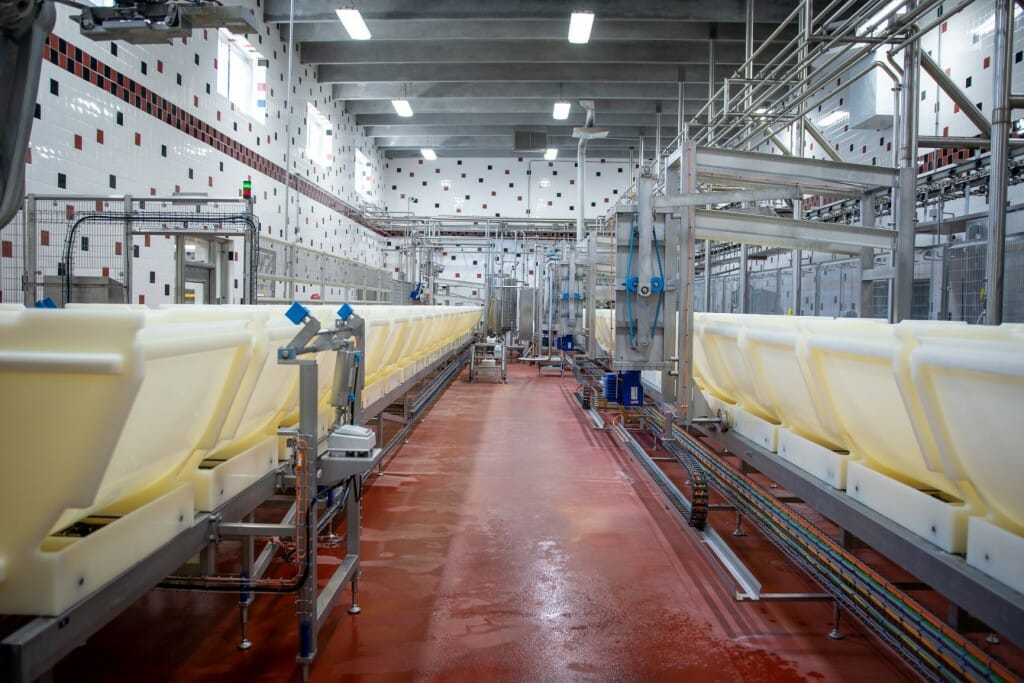
Nasonville Dairy has improved the efficiency of Feta production with the CDR’s help. UW-Madison CALS
In addition to quality and consistency issues, Nasonville Dairy and CDR have worked together to develop new products for export.
“Our new products are all designated for China,” Heiman said. “One of our new products that we worked with CDR on was what we call Snow Feta. That has started out quite well over there.”
Heiman describes Snow Feta as more of a powdered Feta that is sprinkled as a topping on foods like pizzas. “We have been quizzed about other products that we’re making and the idea here is to advance on that,” he said. “We see growth in other parts of the world, like Southeast Asia, these are places that we need to go. We need to continue to evaluate how we’re going to get there.”
In addition, Nasonville Dairy sells Feta, Cheddar and other cheese varieties to China, Japan, Saudi Arabia and other markets. Exports is an area that Heiman is passionate about and he says that more U.S. cheesemakers need to get their products in foreign markets such as Southeast Asia and beyond.
Reverse Engineering Cheese
CDR and Nasonville Dairy have also worked closely together to develop cheeses that have traditionally been imported. “If someone in the U.S. has a cheese they import, we can send that cheese to CDR and get a breakdown of the cheese. CDR will tell us how to manufacture it.” Heiman said.
For instance, Heiman brings up his plant’s Feta production as an example, “Stop and think about how much Feta was coming into this country. Now, people who have Feta in the U.S. will travel to other parts of the world and they’ll go, ‘Nah, it isn’t as good as the Feta at home.’”
There are other examples, such as Queso Blanco. Heiman said there were quality concerns with Queso Blanco that was being imported, “CDR taught a lot of people how to make the product, make it right, and make it safe.”
Going back further in time, Heiman also mentions Blue Cheese. “Stop and think about Roquefort – it was the United States that, when put into a corner, came up with Blue cheese. Now, if you talk about Roquefort, people look at you with eyes crossed because no, it’s Blue cheese. Now they’ve turned around and the people all over the world want to use the term Blue cheese.”
One project that Heiman is especially proud of is “sliceable” Feta Cheese. Nasonville Dairy had a customer that requested a sliceable Feta cheese. At the time, there was a similar cheese available, but it contained additives and the customer wanted an all-natural option. Heiman turned to CDR and, over the course of several years, CDR and Nasonville Dairy were able to develop an all natural Feta Cheese that can be sliced. Heiman laughs about the project because in the end, the customer decided they didn’t want the cheese, but Heiman is still proud of the collaborative, innovative work between Nasonville Dairy and CDR.
Heiman believes this project is also indicative of the increasingly important role of dairy as American consumers look for new flavor profiles and healthy food options. “This is where dairy comes in and CDR can help develop those products that will be usable by a restaurant, portion controlled and be good for you as well. That’s where CDR absolutely shines.”
Holding Up the Integrity of Dairy
“One thing that CDR has always done is that CDR has always protected the integrity of milk and the integrity of cheese. They don’t try to cheat on it,” Heiman said.
For example, as Heiman works with export markets across the globe, he said that they are seeing some poor quality products produced in those foreign countries. These include cheeses where the milkfat is removed and replaced with vegetable oils. As Heiman said, “You get away with it, but the product is not real good.”
Looking ahead, Heiman plans on continuing the collaboration with CDR as Nasonville Dairy is always trying to develop the next new product or interesting flavor profile.
One exciting project that Heiman believes has a lot of potential is the ultrafiltration (UF) of milk. Nasonville Dairy has a new, large-scale bottling line.
The dairy is working with CDR on using UF to develop and produce different lactose-free milks and beverages. In addition to reducing the natural sugars in milk, UF can help concentrate proteins and increase calcium content. The development of dairy beverages is an area with a lot of growth potential.
There are a lot of exciting projects and products being developed at Nasonville, but Heiman said he misses working directly with CDR staff like Dean Sommer and John Jaeggi. Because of travel restrictions, CDR staff have been mostly working remotely or from the University of Wisconsin–Madison campus.
“What we miss tremendously in our industry right now is John and Dean running up and down the road,” Heiman said. “They’re welcome in every plant in the state of Wisconsin.
UW-Madison contributes $20.8 billion per year to the Wisconsin economy, and UW–Madison related start-ups contribute an additional $10 billion. Read more here.

